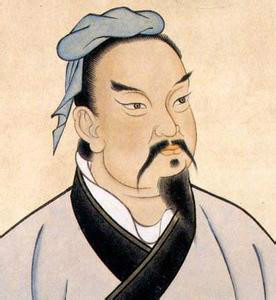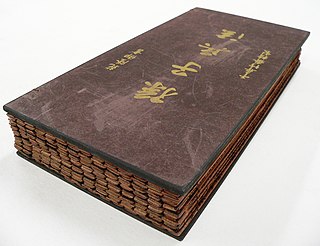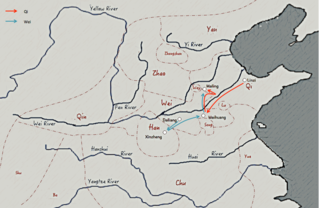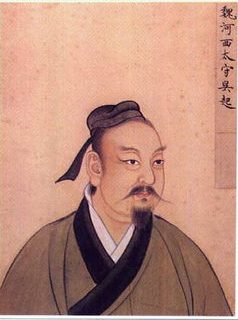
Sun Tzu was a Chinese military general, strategist, philosopher, and writer who lived during the Eastern Zhou period. Sun Tzu is traditionally credited as the author of The Art of War, an influential work of military strategy that has affected both Western and East Asian philosophy and military thought. Sun Tzu is revered in Chinese and East Asian culture as a legendary historical and military figure. His birth name was Sun Wu and he was known outside of his family by his courtesy name Changqing. The name Sun Tzu—by which he is more popularly known—is an honorific which means "Master Sun".

The Art of War is an ancient Chinese military treatise dating from the late Spring and Autumn Period. The work, which is attributed to the ancient Chinese military strategist Sun Tzu, is composed of 13 chapters. Each one is devoted to a different set of skills or art related to warfare and how it applies to military strategy and tactics. For almost 1,500 years, it was the lead text in an anthology that was formalized as the Seven Military Classics by Emperor Shenzong of Song in 1080. The Art of War remains the most influential strategy text in East Asian warfare, has influenced both East Asian and Western military theory and thinking, and has found a variety of applications in myriad competitive non-military endeavors across the modern world including espionage, culture, politics, business, and sports.

The Warring States period was an era in ancient Chinese history characterized by warfare, bureaucratic and military reform, and political consolidation. It followed the Spring and Autumn period and concluded with the wars of conquest that saw the state of Qin annex all the other contender states by 221 BC and found the Qin dynasty, the first imperial dynasty in Chinese history.
Attrition warfare is a military strategy consisting of belligerent attempts to win a war by wearing down the enemy to the point of collapse through continuous losses in personnel, materiel, and morale. The word attrition comes from the Latin root atterere, meaning "to rub against", similar to the "grinding down" of the opponent's forces in attrition warfare.
The Thirty-Six Stratagems is a Chinese essay used to illustrate a series of stratagems used in politics, war, and civil interaction.

Wu Qi was a Chinese military general, philosopher, and politician during the Warring States period.

The Battle of Guìlíng was fought between the states of Qí and Wei in the Warring States period of Chinese history.

The Battle of Maling took place in Maling, currently Dazhangjia Town (大張家鎮), Shen County (莘县), Henan Province, in 342 BC during the Warring States period. The combatants were the State of Qi, who fought on behalf of the State of Han, and the State of Wei. This battle is well recorded in history texts and is famous for the tactics of Sun Bin, known as the "Tactic of Missing Stoves", in which one side is led to underestimate the other by creating an illusion of soldiers running away from the army.

Sun Bin was a Chinese general, military strategist, and writer who lived during the Warring States period of Chinese history. A supposed descendant of Sun Tzu, Sun was tutored in military strategy by the hermit Guiguzi. He was accused of treason while serving in the Wei state and was sentenced to face-tattooing and had his kneecaps removed, permanently crippling him. Sun escaped from Wei later and rose to prominence in the Qi state, by serving as a military strategist and commander. He led Qi to victory against the Wei state at the Battle of Guiling and Battle of Maling. Sun authored the military treatise Sun Bin's Art of War, which was rediscovered in a 1972 archaeological excavation after being lost for almost 2000 years.
High ground is an area of elevated terrain, which can be useful in combat. The military importance of the high ground has been recognized for over 2,000 years, citing early examples from China and other early-dynastic cultures who regularly engaged in territorial/power struggles. Later incorporated to be advantageous in architectural designs such as castles and fortresses which included towers and walls designed to provide structural advantages for positions of troops and weaponry which could be thrown or fired from above.

The Wuzi is a classic Chinese work on military strategy attributed to Wu Qi. It is considered one of China's Seven Military Classics.

The Six Secret Teachings, is a treatise on civil and military strategy traditionally attributed to Lü Shang, a top general of King Wen of Zhou, founder of the Zhou dynasty, at around the eleventh century BC. Modern historians nominally date its final composition to the Warring States period, but some scholars believe that it preserves at least vestiges of ancient Qi political and military thought. Because it is written from the perspective of a statesman attempting to overthrow the ruling Shang dynasty, it is the only one of the Seven Military Classics explicitly written from a revolutionary perspective.
The Battle of Didao, also known as the Battle of Taoxi, was fought between the states of Shu Han and Cao Wei in 255 during the Three Kingdoms period in China. The battle concluded with a Wei victory.

The Tactica is a military treatise written by or on behalf of Byzantine Emperor Leo VI the Wise in c. 895–908, and later edited by his son, Constantine VII. Drawing on earlier authors such as Aelian, Onasander and the Strategikon of emperor Maurice, it is one of the major works on Byzantine military tactics, written on the eve of Byzantium's "age of reconquest". The original Greek title is τῶν ἐν πολέμοις τακτικῶν σύντομος παράδοσις. The Tactica elaborates on a wide variety of issues, such as infantry and cavalry formations, drills, siege and naval warfare etc. It is written in a legislative form of language and comprises 20 Constitutions and an Epilogue and is concluded by 12 additional chapters, the latter mainly focusing on ancient tactics.
King Wei of Qi, whose personal name was Tian Yinqi (田因齊), was the king of the northern Chinese state of Qi during the Warring States period, when Qi was one of the most powerful states in China. He reigned from 356 to 320 BC. or according to another source from 378 to 343 BC. He was the first ruler of Qi to style himself "king".
Pang Juan was an ancient Chinese military general of the Wei state during the Warring States period(5th cent.-221 BCE).He was supreme commander of the joint forces of the allies Zhao, Chu 楚, Wei 魏, Han 韓, and Yan against the "outlaw" Qin 秦. This was the last unified force of the Warring States period, and it pushed Qin back to the town of Zui 蕞 ,
Tian Ji, courtesy name Qi (齐), was a military general of the Qi state during the early Warring States period of Chinese history. Tian Ji met Sun Bin and recommended him to King Wei of Qi as a military strategist. Tian Ji commanded the Qi armies in the Battle of Guiling and Battle of Maling, scoring victories against the Wei state with help and guidance from Sun Bin.

The military of the Warring States refers primarily to the military apparatuses of the Seven Warring States which fought from around 475 BC to 221 BC when the state of Qin conquered the other six states, forming China's first imperial dynasty, the Qin dynasty.












